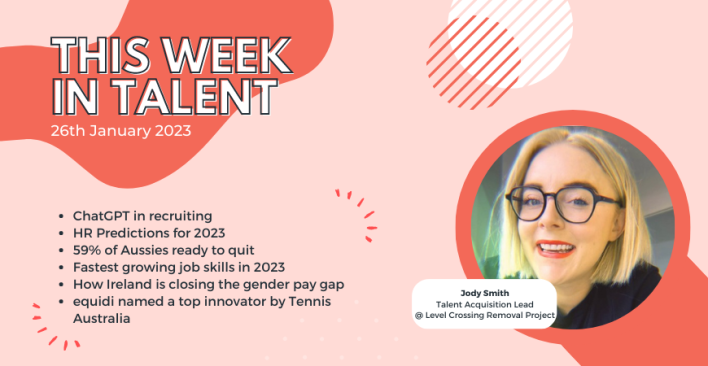Revolutionising Talent Acquisition with ChatGPT and GPT-3: A Recruiter’s Perspective (Part 1)

It happened in the middle of December 2022.
I was looking forward to the holidays while trying to get work done when a LinkedIn post caught my attention about how convenient it was to draft sales and marketing emails using ChatGPT. Having already seen quite a few things in the market already I would normally have move on, but the words like Artificial Intelligence, NLP, and OpenAI caught my attention. So I read a little bit about this ChatGPT thingy. It had over a million subscribers within first week of its launch date and showed no signs of slowing down. I figured that meant some serious stuff and that shouldn’t be ignored.

Having been in HR for almost two decades, my fascination with technology only continues to increase. So I decided to shift my focus towards finding out the avenues how to use ChatGPT in Talent Acquisition space. Some people had given me thought-provoking ideas, so I thought to test them out from both a Recruiter and Candidate’s perspective separately. I also wanted to touch on a few business models that the tech start-ups might be interested in exploring in the ever-changing Talent Acquisition tech landscape.
Due to the breadth of the information that came from these experiments, I’ll cover my findings in two blogs. This part will be uncovering the utilization of ChatGPT from a Recruiter’s perspective. Part two will focus on Candidate’s perspective.
What is ChatGPT and GPT-3?
Being mindful of the varying levels of understandings of the technology out there, let me cover a few basics.
ChatGPT is a conversational artificial intelligence model developed by OpenAI (thank you, Elon Musk and co.), capable of communicating using human-like text-based language. You ask a question and get an answer. Ask for more details and get more details – it’s as simple as that.
GPT-3 is an advanced language model trained on much larger text data comprising hundreds of billions of words. It can perform a wider range of language tasks, including conversation, translation, summarization, and more, all with a high level of accuracy.
For my tech-savvy friends and startups, ChatGPT and GPT-3 use transformer-based neural networks and unsupervised learning pre-training. NLP is utilized to facilitate human communication and perform other language-related tasks. OpenAI’s GPT-3 can be accessed through a developer key, which is where the magic happens. I will elaborate further on it later.
ChatGPT from a Recruiter’s Perspective
Let’s move on to the exciting stuff and review ChatGPT and GPT-3 from the Recruiter or an Organisational perspective.
Sourcing
It seems like sourcing is no longer going to be the specialised niche skill set it used to be. I have successfully developed complicated Boolean strings to source candidates with niche skill sets in specific geographic locations for key target organisations. I worked with ChatGPT to make impressive searches. For example, ChatGPT wasn’t initially willing to add my key competitors in the string, but instead gave me the syntax and left it for me to copy and paste the names. I had to prompt it to do it for me. Also, I had to train the model to understand who my target organisations were and who weren’t. I also had to prompt it a couple of times to provide alternative job titles used in my target organisations. To my surprise, the knowledge base about alternative job titles was much better and accurate than the LinkedIn Recruiter’s suggestions. Once I was happy with my search criteria, ChatGPT provided an accurate Boolean search.
So, you see the point here? As an experienced sourcer, you still hold the key and let ChatGPT’s magic work for you.
Business Case in Sourcing
Integrate the OpenAI’s GPT-3 API into your existing ATS or develop a standalone tool. Train it with hundreds or thousands of resumes. Integrate it with LinkedIn APIs to identify candidates with minimal effort. The tool is also capable of producing X-ray searches on LinkedIn profiles or any other websites for free using web scraping techniques to extract information. The same is possible for other job boards as long as they have APIs to communicate with. This will free up Talent Acquisition resources to focus more on human touch instead of putting most of their effort into candidate identification.
Applications Screening
One of the biggest challenges for recruiters is to screen through tens and hundreds of applications for a role to search those very few gems that they are after. ChatGPT comes to rescue here. Integrate GPT-3 into the existing Applicant Tracking System, and fine tune it by providing with labelled datasets of relevant and irrelevant resumes to the job description to train the model. ChatGPT has the capability to provide high-scoring candidates, doing the initial screening of the candidates, providing an executive level summary of the candidate’s relevant experience, skills, or educational background, extracting contact information, if it is trained using enough time, resources and data.
Interview Scheduling
There are already a few tools, such as Evie, already in the marketplace that work well in interview scheduling. However the enhanced level of NLP of GPT-3 puts it on the forefront. The API can be integrated with Outlook calendar and it can automatically communicate, follow up with and book the interview meetings with the candidates with almost no physical effort.
Drafting Job Descriptions
It is a no brainer to use this tool to draft compelling job descriptions. A simple chat with ChatGPT provides decent descriptions and we can further modify it to the needs. At the next level, by integrating the GPT-3 into the existing ATS, and training the system by providing multiple job descriptions, it has the capability to learn and provide tailored job description as per the company culture and industry jargons. It is much more powerful than majority of the available tools in the market.
Talent Intelligence (TI):
Talent Intelligence has become an emerging field in Talent Acquisition and business strategy over the past few years, requiring a diverse set of skillsets of human resources to connect the dots through Open Source Intelligence (OSINT) and other channels. Connecting the dots can be done better with Artificial Intelligence, which can consume various data sets, recognize patterns, and provide vital information such as competitor analysis, salary and hiring benchmarking, in-demand and future skills analysis, geo-strategic decisions for large organisations, and the development of a live predictive model. It is absolutely doable, however the GPT-3 has to be trained, and the API to be integrated with multiple sources using APIs or web scraping.
While the model may not be perfect overnight, Talent Intelligence will surely be done better by Artificial Intelligence, potentially reducing the number of highly specialised data scientists, developers, dedicated TA professionals, and data hygiene specialists.
Predictive Hiring:
By integrating GPT-3 with ATS and internal HRMSs, it can analyse historical data and candidate information, such as education, experience, titles, and career transitions, to develop a predictive model on a candidate’s success in a role.
What’s the Catch?
Nothing is perfect, and it is important to understand a few shortcomings.
Artificial Intelligence is trained from past data to develop future models, and unless the tool is trained carefully, the predictive model can become highly biased and stagnant. There have been incidents where AI models played a catalyst role in gender bias as the training model, data, and trainers were not considered thoughtfully. The model may not bring out-of-the-box ideas, for example, suggesting that a high-performing engineer be hired for an HR role.
It’s also worth noting that using ChatGPT for Talent Acquisition wouldn’t be without it’s challenges for companies in regards to cyber and data privacy reviews. Larger organisations may be reluctant to their past hiring data on an open source system. We’ve already seen examples of this with Amazon cautioning their employees against sharing sensitive information with the chatbot and PwC warning their staff against inputting client data into ChatGPT to assist with client projects. Limitations on these data inputs may in turn impact 3rd party system integrations (such as the ATS) into ChatGPT.
As the technology is evolving, there is always a room of error and the possibility of getting incorrect information if the algorithm has areas requiring improvement. ChatGPT is not immune to that either.
Another almost unavoidable challenge is the hyper-automation and hyper-AI effect, that I’ll elaborate further in the second part. Until then… Happy Recruiting and do let me know your thoughts in the comments below.
This article is Part 1 of a 2-part blog looking at how ChatGPT and GPT-3 could be used to revolutionise talent acquisition. Part 2, which will look at ChatGPT and GPT-3 from a candidate’s perspective, will be dropping soon.
Cover image: Canva
Related articles
Leave a Reply
Sign up to our newsletter
Get a weekly digest on the latest in Talent Acquisition.
Deliver this goodness to my inbox!


